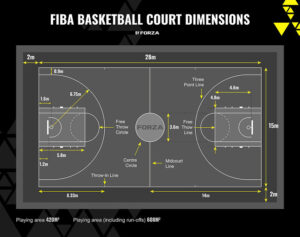Basketball is a popular sport played worldwide, and it is no surprise that educational facilities, such as schools, often have basketball courts to promote physical activity and engage students in team sports. However, not all basketball courts have the same dimensions and in some cases you might have space restrictions when planning to install a basketball court. In this article, we will explore the different basketball court size options available.
TLDR: Basketball courts come in different sizes to accommodate various needs and available space (as summarized below):
- The standard basketball court size is 28 meters by 15 meters
- Half-court basketball courts measure approximately 20 meters by 20 meters areas.
- Basketball key areas can be customized to fit the available space, with dimensions around 10 meters by 8 meters being ideal for accommodating the full key and a partial three-point line.
Standard Basketball Court Size
The standard basketball court size used in professional games and tournaments is 28 meters in length from baseline to baseline and 15 meters in width from sideline to sideline. This size ensures that players have enough space to maneuver and compete effectively. While the dimensions of the court are fixed, the run-off area (the space located outside of the court) can vary. However, it is recommended to have a minimum of 2 meters of space beyond the boundaries to ensure the safety of the players.

Half-Court Basketball Courts
In some cases, educational facilities may opt for half-court basketball courts, especially in areas where space is limited or for recreational purposes. Half-court basketball courts are also quite popular in council areas. These courts are usually around 20 meters in length and 20 meters in width. While half the size of a standard court, they still provide ample space for players to enjoy the game and develop their skills.
Basketball Key Areas
The key areas on a basketball court, also known as the free-throw lane or restricted area, are crucial for various aspects of the game, such as shooting free throws and defending the basket. In educational facilities, basketball key areas can be customized to suit the available space. However, to accommodate the full key and a partial three-point line, the dimensions of the key area should ideally be around 10 meters in length and 8 meters in width. This allows players to practice shooting free throws and gives them a sense of the regulation court dimensions.
Considerations for Educational Facilities
When planning or constructing a basketball court in a school, there are several factors to consider beyond the court size itself. Safety should always be a top priority. It is important to ensure that the playing surface is made of suitable materials, such as high-quality sports flooring or asphalt, which provides good traction and minimizes the risk of injuries. Additionally, installing padding or barriers around the court can further enhance safety and prevent accidents.
Furthermore, proper markings and lines should be painted on the court to indicate the boundaries, key areas, three-point line, and other relevant areas. Clear and visible markings not only help players understand the court dimensions but also contribute to fair play and accurate refereeing during matches or practice sessions.
In Summary
In conclusion, basketball courts come in different sizes to accommodate various needs and available space. While the standard basketball court size is 28 meters by 15 meters, half-court basketball courts measuring approximately 20 meters by 20 meters are also popular, particularly in council areas. Additionally, basketball key areas can be customized to fit the available space, with dimensions around 10 meters by 8 meters being ideal for accommodating the full key and a partial three-point line. When constructing a basketball court, safety should always be a priority, along with clear markings and suitable playing surfaces, to ensure an enjoyable and engaging experience for players.
Note: This article uses International Basketball Federation (FIBA) guidelines for the sizing of courts which is the standard used in Australia for basketball.


